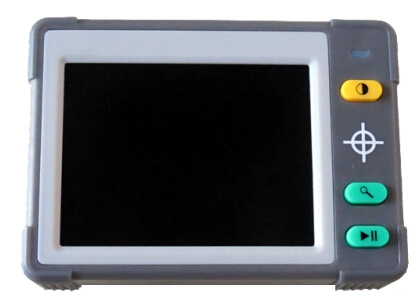Basic Info.
Product Description
Low Vision 3.5" LCD Pocket Video Magnifier Reading Aid,Video Digital Magnifier (BM-EM04)

1, display type: 3.5 inch TFT LCD display (color) 2, screen resolution: QVGA (320x240) 3, brightness: 250cd/M, can not be adjusted 4: can not be adjusted, contrast 5, the lens focal length: 1cm-5cm 6, 3-15 times magnification: (four file multiple regulation) 7, select the display mode: 7 (full color / black text on a white background / black and white / black and yellow word / yellow base blue / white blue word / blue and yellow word) 8, the built-in lithium battery: continuous working time is 3 hours, charging time: 4-6 hours 9, the charger: AV port 10, the external battery: lithium battery (1050 MAH) 11, output power: 5V/1000mA (max) 12, weight: 140 grams (with battery) 13, size: 105mm x 75 mm x 20 mm 14, the fuselage without sound 15, without support, directly on the use of a book, can display connected TV, another optional adapter connected to the computer, use the. 16, packing: neutral white box packaging |

12pcs/ctn
41x24.5x34.5cm
6/7kg


The low vision 3.5" LCD pocket video magnifier reading aid, also known as a video digital magnifier, is a specialized magnifying tool designed to help individuals with low vision read and view printed material more easily. It is a portable, handheld device that features an LCD screen and a built-in camera that captures images of text or objects and displays them on the screen at a magnified level.
The pocket video magnifier typically has a magnification range of 2x to 16x, which is adjustable to suit the user's needs. The LCD screen is typically around 3.5 inches in size, which provides a clear and detailed view of the magnified image.
The device is designed to be portable and easy to use, with simple controls and a lightweight, compact design that can easily fit into a pocket or purse. It is powered by rechargeable batteries, which provide several hours of use on a single charge.
The video digital magnifier is ideal for reading small print, examining photographs, and viewing other small objects. It can be used in a variety of settings, including at home, at school, or in the workplace. Additionally, it can be helpful for individuals with conditions that affect vision, such as macular degeneration, cataracts, or glaucoma.




